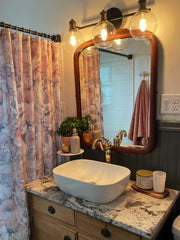
How to Install a Vessel Sink
When it comes to elevating the aesthetic appeal of your bathroom, installing a vessel sink can make a significant difference. Vessel sinks are freestanding sinks that sit on top of a countertop, rather than being built into the countertop like a traditional sink. This gives them a more modern and elegant look, and they can be a great way to add a touch of luxury to your bathroom. However, proper installation and thoughtful faucet selection are important to achieving the desired outcome. If you're not careful, a poorly installed vessel sink can look out of place or even downright ugly. And the wrong faucet or sink placement can make the sink look unbalanced or even cheap. That's why we've put together this guide to properly installing a vessel sink and guidelines for faucet placement. In this article, we'll explore vessel sinks in the bathroom, provide guidelines on faucet placement, and offer a step-by-step guide to installing a vessel sink. Ultimately, we will uncover the art of harmonizing form and function in your bathroom sanctuary.
All About Vessel Sinks

Vessel sinks, with their captivating presence, have become a coveted addition to contemporary bathroom design. These stylish and distinctive fixtures sit gracefully atop the bathroom counter, defying conventional norms and creating a visually striking focal point. Since they sit on top of the counter rather than being recessed, vessel sinks can be easily installed on a variety of surfaces such as stone, wood, or glass. This flexibility opens up a world of design possibilities, allowing you to create a truly custom bathroom space that reflects your personal taste.
One of the key attributes that make vessel sinks so appealing is their unique design, offered in a variety of shapes, sizes, and materials, allowing you to personalize your bathroom and infuse it with your preferred aesthetic. Whether you prefer the clean lines of a rectangular vessel sink or the organic curves of a round or oval one, there is a vessel sink to match every bathroom decor theme. In addition to their aesthetic allure, vessel sinks have practical advantages as well. Their raised position allows for a more comfortable and ergonomically friendly experience, as they eliminate the need to bend over excessively. This can be particularly beneficial for individuals with mobility issues or back problems, making daily tasks like handwashing and toothbrushing more comfortable.
Before you’re ready to install, be sure to pick out your favorite deck-mount, wall-mount, or vessel-specific faucet. When it comes to simplicity and functionality, single-hole faucets are an excellent choice for vessel sinks. These sleek faucets feature a single spout and handle, creating a compact design that perfectly complements a freestanding sink. With their clean lines and minimalist appeal, single-hole faucets effortlessly blend with various vessel sink styles. The convenience they offer is an added bonus, as the single handle controls both water temperature and flow, providing ease of use. Another faucet option is wall-mounted and is installed on the wall behind the vessel sink. Having your faucet wall-mounted results in a clean and clutter-free countertop surface, and creates an aura of modern sophistication, making wall-mounted faucets an ideal choice for contemporary bathroom designs. When it comes to vessel sinks, tall vessel faucets rise to the occasion. These faucets are specifically designed with an extended spout to accommodate the height of taller vessel sinks. Deciding on a tall vessel faucet might save you some hassle if you have a uniquely tall vessel sink.

To achieve a polished look when installing your vessel sink, pay attention to the delightful little details. Color coordination is the secret ingredient to a cohesive aesthetic. Matching the finish of your faucet with other bathroom fixtures, such as towel bars and shower heads, creates a captivating symphony of hues. Think about captivating options like gleaming polished brass, sophisticated brushed nickel, or the warmth of oil rubbed bronze. By selecting finishes that harmonize with each other, you'll elevate the overall visual appeal and create a breathtaking visual experience. Some commonly overlooked details are often small components or trim pieces. Create more cohesion by adding an overflow hole cover or pop-up drain in the same finish. Also note that if your vessel sink does not have an overflow hole, it will require a compatible drain.
Now, let's take a peek beneath the sink. If you have exposed plumbing, or functional pipes that are in line of sight, they shouldn't be overlooked. Even though you don’t physically interact with exposed plumbing, it can make a visual impact on your design. For the more common p-trap, elevate it with a stunning brushed brass, or mix up the expected with a bold matte black on a sleek and modern bottle trap. There are endless pairings possible to fit your bathroom’s style, so don’t fret if you’re feeling limited in design.
The Best Faucet Placement for Vessel Sinks

If your project is a DIY at-home renovation or outsourced to a professional contractor or a specialized designer, draft a plan before any drilling or cutting. When installing a wall-mount faucet, it is essential to consider the optimal height and reach as well as the positioning of the spout. The optimal height of the faucet plays a significant role in convenience. It is recommended to have a distance of at least 6 inches from the bottom of the sink basin to the faucet spout. This ensures that there is ample space for comfortable handwashing and to minimize any splashing. By maintaining this height, you can create an ergonomic environment that prioritizes ease of use. Moreover, the reach of the faucet spout is another important factor to consider. It should have sufficient length to allow water to flow directly into the sink without splashing outside. Finding the right balance between comfort and functionality is key here.
In addition to height and reach, the positioning of the spout contributes to both aesthetics and practicality. It is recommended to align the faucet spout with the center of the sink drain. Aligning the spout with the drain facilitates efficient water flow, preventing any disruptions or unnecessary splashing that may occur due to misalignment. By adhering to these guidelines, you can enhance the visual appeal of your sink area.

By deviating from traditional built-in sinks and opting for a freestanding design, vessel sinks introduce a contemporary and elegant element to the space. It is paramount to emphasize the significance of proper installation and meticulous faucet selection to achieve the desired outcome. A poorly executed installation will absolutely ruin any big plans for a bathroom renovation. Likewise, a misalignment between the faucet and sink placement can disrupt the visual balance and compromise the quality. Nevertheless, a vessel sink and vessel faucet pairing are a great choice to elevate your renovation design plan, and to wrap it up, it’s time to install!
Step-by-Step Guide to Install a Vessel Sink
Step 1: Prepare the Area
Start by turning off the water supply to the sink. Locate the shut-off valves beneath the sink and turn them clockwise until they are fully closed. Place towels or a bucket underneath the plumbing connections to catch any water that may drip during the installation process.
Step 2: Remove the Existing Sink (if applicable)
If you have an existing sink, you'll need to remove it first. Use a screwdriver or adjustable wrench to disconnect the water supply lines and the drain pipe. Remove any mounting hardware that secures the sink to the countertop including any old putty or caulking. Lift the old sink out and clean the area thoroughly.
Step 3: Prepare the Countertop

Ensure that the countertop is level and clean. Measure the diameter of the vessel sink's base and mark the center on the countertop. Cut a hole using a drill and appropriate drill bit following the dimensions for your vessel sink drain hole.
Step 4: Install the Vessel Sink
Apply a thin layer of clear caulking around the drain hole. Place the vessel sink on the counter and align the sink drain opening with the previously cut drain hole. Clean any excess caulking immediately.
Step 5: Install the Drain Assembly

Apply silicone adhesive or plumber's putty to the underside of the drain flange. Insert the drain flange through the sink's drain hole and position it properly. From underneath the sink, place the rubber gasket, followed by the plastic washer, and finally, the nut. First, tighten by hand, and then tighten with a wrench. Be careful not to overtighten, as it may damage the sink or cause leaks.
Step 6: Install the Faucet & Connect the Water Supply Lines
Install your desired faucet then reconnect the water supply lines to the faucet. Use an adjustable wrench to tighten the connections, ensuring they are snug but not overly tight.
Step 7: Test for Leaks
Slowly turn on the water supply valves and check for any leaks around the connections. If you notice any leaks, tighten the connections slightly or add plumber's tape as necessary.
